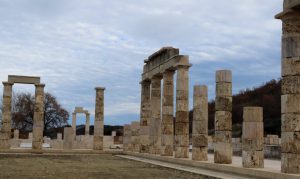The palace of Aigai was a centrepiece of Philip II’s (359-336 B.C.) building programme to modernise the royal capital of Macedon. By far the largest structure constructed in classical Greece (roughly 15,000 sq.m.), Philip spared no expense in materials, ingenuity and skill; utilising the latest technological developments and with a clear focus on geometrical simplicity of form, his architects erected a monument of unparalleled clarity, elegance and harmony, all in service of metre.
It is a UNESCO-certified world heritage site and includes some of the most striking archaeological findings of the 20th century.
The maintenance, reinforcement, restoration and reconstruction of the monument was a long process, lasting from 2007 to 2023, and was co-funded by successive European Programmes of an overall budget of €20,300,000. A public expenditure of €10,000,000 was included in the project under the Operational Programme Competitiveness, Entrepreneurship and Innovation (NSRF 2014 – 2020), co-funded by the European Regional Development Fund (ERDF) of the European Union.
Prime Minister Kyriakos Mitsotakis inaugurated the restored palace of Aigai in an official ceremony on Friday, 5/1/2024. The restored palace is now open to the public.
The completion of the project is expected to significantly bolster the already increased tourist traffic at the Aigai archaeological site as well as throughout Imathia and Central Macedonia overall. In addition, it is projected to lead to increases in jobs in the region and contribute to educational – cultural events, positively impacting the quality of life of both locals and visitors. Thanks to the project, a monument that’s rightly been included among the treasures of our global cultural heritage has now been upgraded and made available to the citizens of Europe as it was meant to be.
For more information about the project, click here






